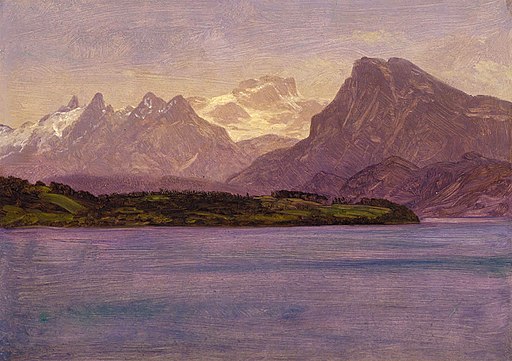
“Alaskan Coastal Range” by Albert Bierstadt
“Alaskan Coastal Range” by Albert Bierstad is an oil-on-paper sketch that he made for further detailing as later work. It was painted after traveling through British Columbia.
Bierstadt traveled through western Canada in 1889 on the Canadian Railway. He then took a steamship to Alaska, searching for more rugged landscapes, and was shipwrecked in Loring, Alaska.
He lived with the other passengers in Native American huts. While sheltering in the Native American settlement, he drew the sea’s shores and his Alaskan surroundings.
The colors and thin layers of paint evoke the wilderness in which Bierstadt was stranded. He filled two books with drawings and paintings of his surroundings.
By the time of his death in 1902, the taste for epic landscape painting had subsided.
Bierstadt was then largely forgotten. However, interest in Bierstadt’s work was renewed in the 1960s with the exhibition of his small oil studies such as this one.
Coast Mountains
The Coast Mountains are a major mountain range of western North America. It extends from southwestern Yukon through the Alaska Panhandle and virtually all of the Coast of British Columbia.
The mountain range’s name derives from its proximity to the sea coast. The range includes volcanic and non-volcanic mountains and extensive ice fields.
The Coast Mountains are part of the Pacific Ring of Fire, the ring of volcanoes and associated mountains around the Pacific Ocean.
Loring, Alaska
Loring was established in 1885, just a few years before this painting. By 1890 it had 200 residents and was a service center for the area’s fishing and timber industries, but today it has just a handful of people.
Alaskan Coastal Range
-
- Title: Alaskan Coastal Range
- Artist: Albert Bierstadt
- Year: 1889
- Medium: oil on paper mounted on paperboard
- Dimensions Height: 35.2 cm (13.8 in); Width: 49.2 cm (19.3 in)
- Movement: Hudson River School
- Category: American Artist
- Museum: Smithsonian American Art Museum
Albert Bierstadt
Albert Bierstadt (1830 – 1902) was a painter of sweeping landscapes of the American West. He joined several journeys of the Westward Expansion to paint the scenes.
Bierstadt was born in Prussia, but his family moved to the United States when he was 1. He returned to Europe to study painting for several years in Düsseldorf.
He became part of the second generation of the Hudson River School in New York, an informal group of like-minded painters who started painting along the Hudson River.
Bierstadt was a critical interpreter of the western landscape, and he is also grouped with the Rocky Mountain School.
Albert Bierstadt
- Artist: Albert Bierstadt
- Born: 1830, Solingen, Rhine Province, Prussia
- Died: 1902 (aged 72), New York City
- Nationality: German-American
- Notable works:
- The Falls of St. Anthony
- Looking Down Yosemite Valley, California
- Alaskan Coastal Range
- The Rocky Mountains, Lander’s Peak
- North Fork of the Platte Nebraska
Albert Bierstadt’s Lavish Landscapes of The American West
Tour of the Smithsonian American Art Museum
- “Skating in Central Park” by Agnes Tait
- “Buffalo Hunt on the Southwestern Prairies” by John Mix Stanley
- “Surrender of a Confederate Soldier” by Julian Scott
- “Westward the Course of Empire Takes Its Way” by Emanuel Leutze
- “The Headless Horseman Pursuing Ichabod Crane” by John Quidor
- “The Figurine” by William McGregor Paxton
- “Aurora Borealis” by Frederic Edwin Church
“Albert Bierstadt: Witness to a Changing West”
American Landscape Painting: Albert Bierstadt and the American Land
Tour of American Artists You Should Know
- John Singleton Copley (1738 – 1815)
- Benjamin West (1738 – 1820)
- Gilbert Stuart (1755 – 1828)
- John Trumbull (1756 – 1843)
- Edward Hicks (1780 – 1849)
- George Caleb Bingham (1811 – 1879)
- John Mix Stanley (1814 – 1872)
- Emanuel Gottlieb Leutze (1816 – 1868)
- Frederic Edwin Church (1826 – 1900)
- Albert Bierstadt (1830 – 1902)
- James Abbott McNeill Whistler (1834 – 1903)
- Winslow Homer (1836 – 1910)
- Mary Cassatt (1844 – 1926)
- Julian A. Scott (1846 – 1901)
- Daniel Chester French (1850 – 1931)
- John Singer Sargent (1856 – 1925)
- Childe Hassam (1859 – 1935)
- Frederic Remington (1861 – 1909)
- William McGregor Paxton (1869 – 1941)
- George Bellows (1882 – 1925)
- Edward Hopper (1882 – 1967)
- Grant Wood (1891 – 1942)
- Norman Rockwell (1894 – 1978)
~~~
“The best material for the artist is the world.”
– Albert Bierstadt
~~~
Photo Credit: 1) By Wikipedia; Albert Bierstadt / Public domain
Popular this Week








 Sponsor your Favorite Page
Sponsor your Favorite Page SEARCH Search for: Search Follow UsJoin – The JOM Membership Program
Sponsor a Masterpiece with YOUR NAME CHOICE for $5
Share this:
- Tweet
